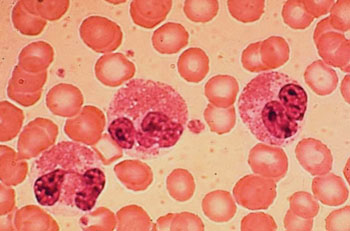Peripheral Blood Eosinophilia Correlates with Hyperplastic Nasal Polyp Growth
By LabMedica International staff writers
Posted on 22 Jun 2016
A reliable way to track the course of nasal polyps in chronic sinus disease, maybe linked to rising levels of immune system white blood cells, called eosinophils, with regrowth of polyps removed by surgery.Posted on 22 Jun 2016
These findings could lead to the development of a simple blood test to screen for early growth of polyps in sinus disease, track disease progression, and develop and monitor treatments for a common, often troublesome condition, called chronic rhinosinusitis with nasal polyposis.

Image: A peripheral blood film showing three eosinophils from a patient with eosinophilia (Photo courtesy of the University of Maryland).
Scientists at the University of Maryland Medical School (Baltimore, MD, USA) and their colleagues studied 61 male and female patients ages 18 to 77 with chronic sinusitis and nasal polyps who were scheduled to have surgery to remove the polyps. Fifty-eight of the patients also had asthma. They analyzed the fluctuation of peripheral blood eosinophilia (PBE) and nasal polyp load in each patient assessed preoperatively, 1 to 2 months postoperatively, and 3 to 12 months postoperatively. Nasal polyp load was assessed using computed tomography (CT) scan preoperatively and nasal endoscopy postoperatively.
The investigators measured, on average, 807 eosinophils/mm3 in patients before their sinus surgery, a level that dropped to an average of 200/mm3 one to two months after the polyps were removed. Over the next nine months, the physicians observed the eosinophils rise again to a high average of 338/mm3, presumably due to the regrowth of the nasal polyps. When nasal polyp load increased with time, we observed a stepwise increase in eosinophil counts. They found that for every time eosinophil number decreased by 100 counts/mm3 after surgery, the nasal endoscopy score dropped by 1.6 units, and, as the eosinophil levels rose again by 100 counts/mm3, the nasal endoscopy score also increased by 1.2 units.
Jean Kim, MD, PhD, an associate professor of otolaryngology-head and neck surgery, and senior author of the study said, “Unlike other airway diseases, like asthma, doctors don't have a single test or biomarker for detecting and tracking sinus-related diseases. A simple blood test would provide an additional way to monitor disease progression, in addition to endoscopies and CT scans for people with symptoms that may enable the ability to screen for sinus disease with nasal polyposis at a primary care facility.” The study was published on May 13, 2016, in the journal International Forum of Allergy & Rhinology.
Related Links:
University of Maryland Medical School














